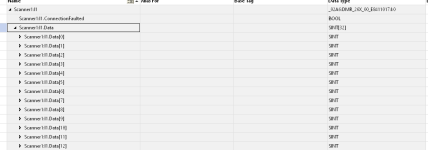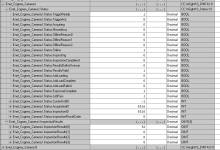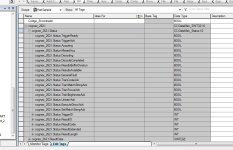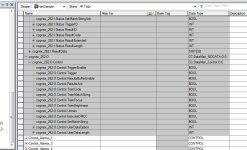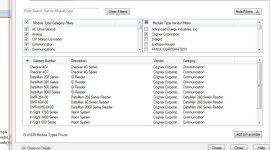This is an excerpt from Cognex Dataman Communications and Programming Guide
-----------------------------------------------------------------
INPUTS
TriggerReady: Indicates when the DataMan reader can accept a new trigger. This tag is True when the Control tag “TriggerEnable” has been set and the sensor is not currently acquiring an image.
TriggerAck: Indicates when the DataMan reader has been triggered (i.e. the Control tag “Trigger” has been set to True). This tag will stay set until the Trigger tag is cleared.
Acquiring: Indicates when the DataMan reader is currently acquiring an image; either by setting the Trigger bit or by an external trigger.
MissedAcq: Indicates when the DataMan reader misses an acquisition trigger; cleared when the next successful acquisition occurs.
Decoding: Indicates when the DataMan reader is decoding an acquired image.
DecodeCompleted: Tag value is toggled (1->0 or 0->1) on the completion of a decode.
ResultsBufferOverrun: Indicates when the DataMan reader has discarded a set of decode results because the results queue is full. Cleared when the next set of results are successfully queued.
ResultsAvailable: Indicates when a set of decode results are available (i.e. the ResultID, ResultCode, ResultLength and ResultsData tags contain valid data).
GeneralFault: Indicates when a fault has occurred (i.e. Soft event “SetMatchString” or “ExecuteDMCC” error has occurred).
TrainCodeAck: Indicates that the soft event “TrainCode” has completed.
TrainMatchStringAck: Indicates that the soft event “TrainMatchString” has completed.
TrainFocusAck: Indicates that the soft event “TrainFocus” has completed.
TrainBrightnessAck: Indicates that the soft event “TrainBrightness” has completed.
UnTrainAck: Indicates that the soft event “UnTrain” has completed.
ExecuteDmccAck: Indicates that the soft event “ExecuteDMCC” has completed.
SetMatchStringAck: Indicates that the soft event “SetMatchString” has completed.
TriggerID: Value of the next trigger to be issued. Used to match triggers issued with corresponding result data received later.
ResultID: The value of TriggerID when the trigger that generated these results was issued. Used to match TriggerID’s with result data.
ResultCode: Indicates success/failure of this set of results.
- Bit 0 ,1=read 0=no read
- Bit 1 ,1=validated 0=not validated (or validation not in use)
- Bit 2 ,1=verified 0=not verified (or verification not in use)
- Bit 3 ,1=acquisition trigger overrun
- Bit 4 ,1=acquisition buffer overflow (not the same as result buffer overflow).
- Bits 5-15 , reserved (future use)
ResultExtended: Currently unused.
ResultLength: Number of bytes of result data contained in the ResultData tag.
ResultData: Decode result data.
OUTPUTS:
TriggerEnable: Setting this tag enables EtherNet/IP triggering. Clearing this field disables the EtherNet/IP triggering.
Trigger: Setting this tag triggers an acquisition when the following conditions are met:
- The TriggerEnable tag is set.
- No acquisition/decode is currently in progress.
- The device is ready to trigger.
ResultsBufferEnable: When set, the decode results will be queued. Results are pulled from the queue (made available) each time the current results are acknowledged. until acknowledged by the PLC. The Decode ID, Decode Result and Decode ResultsData fields are held constant until the ResultsAck field has acknowledged them and been set. The DataMan reader will respond to the acknowledgement by clearing the ResultsValid bit. Once the ResultsAck field is cleared the next set of decode results will be posted.
ResultsAck: The ResultsAck tag is used to acknowledge that the PLC has read the latest results. When ResultsAck is set, the ResultsAvailable tag will be cleared. If results buffering is enabled the next set of results will be made available when the ResultsAck tag is again cleared.
TrainCode: Changing this tag from 0 to 1 will cause the train code operation to be invoked.
TrainMatchString: Changing this tag from 0 to 1 will cause the train match string operation to be invoked.
TrainFocus: Changing this tag from 0 to 1 will cause the train focus operation to be invoked.
TrainBrightness: Changing this tag from 0 to 1 will cause the train brightness operation to be invoked.
Untrain: Changing this tag from 0 to 1 will cause the un-train operation to be invoked.
ExecuteDMCC: Changing this tag from 0 to 1 will cause the DMCC operation to be invoked. A valid DMCC command string must be written to UserData prior to invoking this soft event.
SetMatchString: Changing this tag from 0 to 1 will cause the set match string operation to be invoked. The match string data must be written to UserData prior to invoking this soft event.
UserDataOption: Currently unused.
UserDataLength: Number of bytes of user data contained in the UserData tag.
UserData: This data is sent to the DataMan reader to support acquisition and/or decode.
Note: You must manually add UserData to the output assembly by configuring the DataMan module in RSLogix 5000.
Perform the following steps on a CompactLogix or ControlLogix PLC:
- 1. Right click the DataMan module and select Properties.
- 2. Under Module Definition, click Change.
- 3. The Module Definition window pops up. Under the Output Data to Sensor drop-down menu, select SINT–484.
- 4. Click OK. RSLogix 500 is now updating the Module Definition.
The output assembly controller tags will now list UserData as part of the output assembly.
